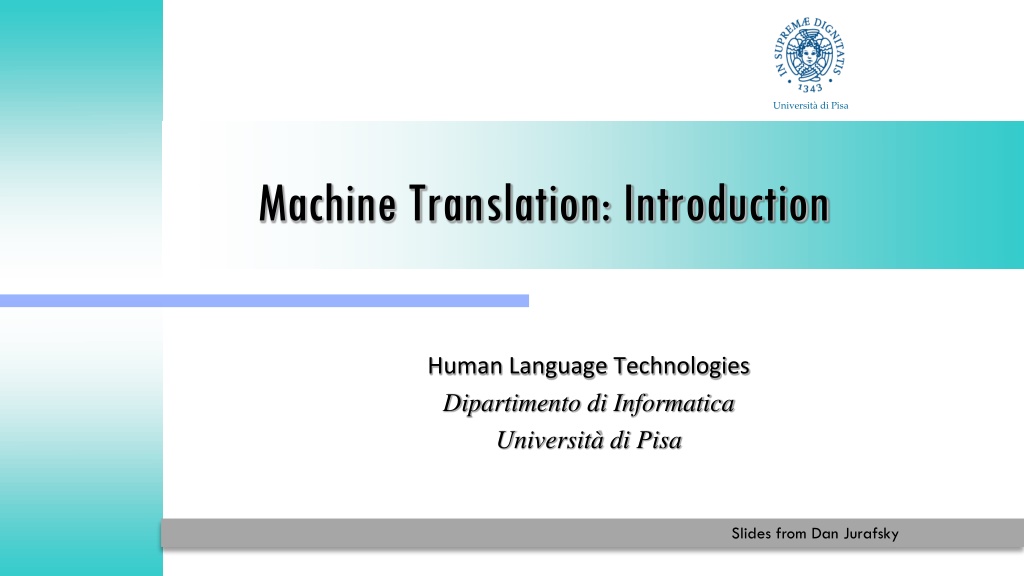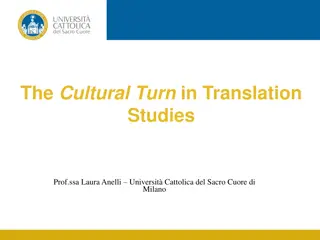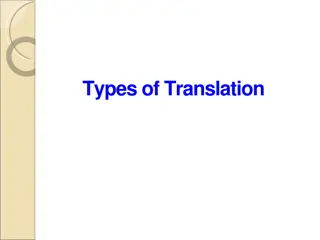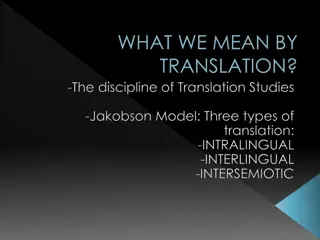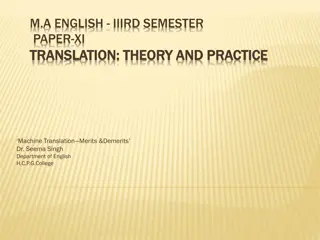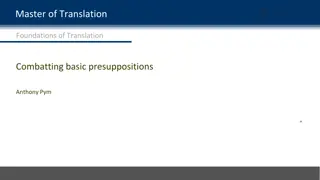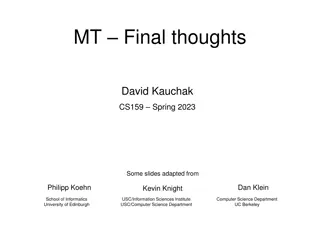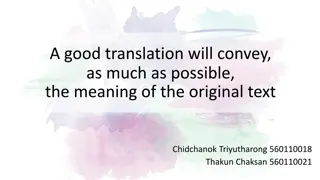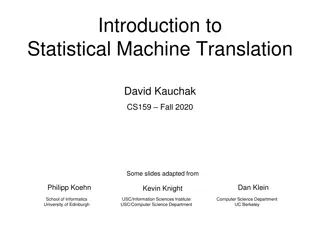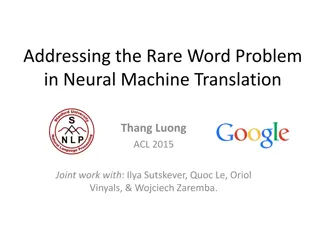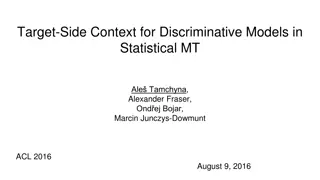Understanding Machine Translation: Challenges and Solutions
This material covers the basics of Machine Translation (MT), including a brief history, classic MT approaches, and modern techniques like Statistical MT and Neural MT. It also presents case studies using Google Translate for language translation and discusses the issues faced in MT, such as sentence segmentation and grammatical differences between languages.
Download Presentation

Please find below an Image/Link to download the presentation.
The content on the website is provided AS IS for your information and personal use only. It may not be sold, licensed, or shared on other websites without obtaining consent from the author. Download presentation by click this link. If you encounter any issues during the download, it is possible that the publisher has removed the file from their server.
E N D
Presentation Transcript
Universit di Pisa Machine Translation: Introduction Human Language Technologies Dipartimento di Informatica Universit di Pisa Slides from Dan Jurafsky
Outline Intro and a little history Language Similarities and Divergences Three classic MT Approaches Transfer Interlingua Direct Modern Statistical MT Neural MT Evaluation
What is MT? Translating a text from one language to another automatically
Google Translate The translation http://translate.google.com/translate?hl=en&sl= es&tl=en&u=http%3A%2F%2Fwww.cocinadomini cana.com%2Facompanamientos-ensaladas- pastelones%2F1907-tostones.html Fried banana is eaten in many parts of Latin America, and especially in the Caribbean Pl tano frito se come en much simas partes de Latinoam rica, y en especial en el Caribe The original recipe for tostones http://www.cocinadominicana.com/acompanam ientos-ensaladas-pastelones/1907-tostones.html
Google Translate French recipe http://translate.google.com/translate?hl=en&sl=fr&u=http://www.tarte-tatin.info/recette-tarte- tatin.html&ei=BduiSYK3C4KOsQObvLm_CQ&sa=X&oi=translate&resnum=4&ct=result&prev=/sear ch?q=tarte+tatin+recettes&num=100
Machine Translation The Story of the Stone ( The Dream of the Red Chamber ) Cao Xueqin 1792 Chinese gloss: Dai-yu alone on bed top think-of-with-gratitude Bao- chai again listen to window outside bamboo tip plantain leaf of on- top rain sound sigh drop clear cold penetrate curtain not feeling again fall down tears come Hawkes translation: As she lay there alone, Dai-yu s thoughts turned to Bao-chai. Then she listened to the insistent rustle of the rain on the bamboos and plantains outside her window. The coldness penetrated the curtains of her bed. Almost without noticing it she had begun to cry.
Machine Translation Issues: Sentence segmentation: 4 English sentences to 1 Chinese Grammatical differences Chinese rarely marks tense: As, turned to, had begun tou penetrated No pronouns or articles in Chinese Stylistic and cultural differences Bamboo tip plantain leaf bamboos and plantains Ma curtain curtains of her bed Rain sound sigh drop insistent rustle of the rain
Not just literature Hansards: Canadian parliamentary proceedings
What is MT already good enough for? Tasks for which a rough translation is fine Extracting information (finding recipes!) Web pages email Tasks for which MT can be post-edited MT as first pass Computer-aided human translation Tasks in sublanguage domains where high-quality MT is possible FAHQT (Fully Automatic High Quality Translation)
What is MT not yet good enough for? Really hard stuff Literature Natural spoken speech (meetings, court reporting) Really important stuff Medical translation in hospitals Emergency phone calls
MT History 1946 Booth and Weaver discuss MT at Rockefeller foundation in New York 1947-48 idea of dictionary-based direct translation 1949 Weaver memorandum popularized idea 1952 all 18 MT researchers in world meet at MIT 1954 IBM/Georgetown Demo Russian-English MT 1955-65 lots of labs take up MT
Warren Weaver memo http://www.stanford.edu/class/linguist289/weaver001.pdf There are certain invariant properties which are to some statistically useful degree, common to all languages. On March 4, 1947, having considerable exposure to computer design problems during the war, and being aware of the speed, capacity, and logical flexibility possible in modern electronic computers , Weaver suggested that computers to be used for translation
History of MT: Pessimism 1959/1960: Bar-Hillel Report on the state of MT in US and GB Argued FAHQT too hard (semantic ambiguity, etc.) Should work on semi-automatic instead of automatic His argument: Little John was looking for his toy box. Finally, he found it. The box was in the pen. John was very happy. Only human knowledge lets us know that playpens are bigger than boxes, but writing pens are smaller His claim: we would have to encode all of human knowledge
History of MT: Pessimism The ALPAC report Headed by John R. Pierce of Bell Labs Conclusions: Supply of human translators exceeds demand All the Soviet literature is already being translated MT has been a failure: all current MT work had to be post-edited Sponsored evaluations which showed that intelligibility and informativeness was worse than human translations Results: MT research suffered Funding loss Number of research labs declined Association for Machine Translation and Computational Linguistics dropped MT from its name
History of MT 1976 Meteo, weather forecasts from English to French Systran (Babelfish) been used for 40 years 1970 s European focus in MT; mainly ignored in US 1980 s ideas of using early AI techniques in MT (KBMT, CMU) Focus on interlingua systems, especially in Japan 1990 s Commercial MT systems Statistical MT Speech-to-speech translation 2000 s Statistical MT takes off Google Translate 2015 Neural MT takes off
Language Similarities and Divergences Some aspects of human language are universal or near-universal, others diverge greatly Typology: the study of systematic cross-linguistic similarities and differences What are the dimensions along with human languages vary?
Morphology Morpheme Minimal meaningful unit of language Word = Morpheme+Morpheme+Morpheme+ Stems: also called lemma, base form, root, lexeme hope+ing hoping hop hopping Affixes Prefixes: Antidisestablishmentarianism Suffixes: Antidisestablishmentarianism Infixes: hingi (borrow) humingi (borrower) in Tagalog Circumfixes: sagen (say) gesagt (said) in German
Morphological Variation Isolating languages Cantonese, Vietnamese: each word generally has one morpheme Vs. Polysynthetic languages Siberian Yupik ( Eskimo ): single word may have very many morphemes Agglutinative languages Turkish: morphemes have clean boundaries Vs. Fusion languages Russian: single affix may have many morphemes
One word one phrase Turkish uygarla t ramad klar m zdanm s n zcas na uygar+la +t r+ama+d k+lar+ m z+dan+m +s n z+cas na Behaving as if you are among those whom we could not cause to become civilized German Donaudampfschiffahrtselektrizit tenhauptbetriebswerkbauunterbeamtengesellsc haft Danube steam shipping electricity main plant construction subordinate company Donaudampfschifffahrtsgesellschaftskapit n Donau+dampf+Schiffahrts+gesellschafts+kapit n Danube steam shipping company captain
Index of synthesis isolating synthetic Vietnamese English Russian Oneida Slide from Holger Diessel
Isolating language Vietnamese (Comrie 1981: 43) Khi t i n nh b n, When I come house friend PL I begin do lesson ch ng t i b t u l m b i. When I came to my friend s house, we began to do lessons. Cantonese keui wa chyuhn gwok jeui daaih gaan nguk haih li gaan he say entire country most big building house is this building Slide from Holger Diessel
Synthetic language (2) Kirundi (Whaley 1997:20) Y-a-bi-gur-i-ye CL1-PST-CL8.them-buy-APPL-ASP ab na CL2.children He bought them for the children. Slide from Holger Diessel
Polysynthetic language Noun-incorporation (cf. fox-hunting, bird-watching) (3) Mohawk (Mithun 1984: 868) a. r-ukwe t- :yo he-person-nice He is a nice person b. wa-hi- sereth- hare- se PST-he/me-car-wash-for He car-wash for me (= He washed my car) c. kvtsyu v-kuwa-nya t- : ase fish FUT-they/her-throat-slit They will throat-slit a fish Slide from Holger Diessel
Index of fusion agglutinative fusional Swahili Russian Oneida Slide from Holger Diessel
Agglutinative language (1) Turkish (Comrie 1981: 44) SG PL Nominative adam Accusative adam-K Genitive Dative Locative Ablative adam-lar adam-lar-K adam-lar-Kn adam-lar-a adam-lar-da adam-lar-dan adam-Kn adam-a adam-da adam-dan Slide from Holger Diessel
Fusional language (2) Russian SG PL SG PL Nominative Accusative Genitive Dative Instrumental Prepositional stol-e stol stol stol-a stol-u stol-om stol-ami lip-oj stol-ax stol-y stol-y stol-ov stol-am lip-e lip-a lip-u lip-y lip-y lip-y lip lip-am lip-ami lip-ax lip-e Slide from Holger Diessel
Word Order SVO (Subject-Verb-Object) languages English, German, French, Mandarin SOV Languages Japanese, Hindi VSO languages Irish, Classical Arabic SVO languages generally use prepositions: to Yuriko VSO languages generally use postpositions: Yuriko ni
Segmentation Variation Not every writing system has word boundaries marked Chinese, Japanese, Thai, Vietnamese Some languages tend to have sentences that are quite long, closer to English paragraphs than sentences: Modern Standard Arabic, Chinese
Inferential Load: cold vs. hot langs Some cold languages require the hearer to do more figuring out of who the various actors in the various events are: Japanese, Chinese Other hot languages are pretty explicit about saying who did what to whom: English
Inferential Load (2) All noun phrases in blue do not appear in the Chinese text But they are needed for a good translation
Lexical Divergences Word to phrases: English computer science = French informatique POS divergences English: she likes/VERB to sing German: Sie singt gerne/ADV English: I m hungry/ADJ Spamish: tengo hambre/NOUN
Lexical Divergences: Specificity Grammatical constraints English has gender on pronouns, Mandarin not. So translating 3rd person from Chinese to English, need to figure out gender of the person! Similarly from English they to French ils/elles Semantic constraints English: brother Mandarin: gege (older) versus didi (younger) English: wall German: Wand (inside) Mauer (outside) German: Berg English: hill or mountain
Lexical Divergence: lexical gaps Japanese: no word for privacy English: no word for Cantonese haauseun or Japanese oyakoko (something like `filial piety ) English cow vs. beef , Cantonese ngau English fish , Spanish pez vs. pescado
Event-to-argument divergences English The bottle floated out. Spanish La botella sali flotando. The bottle exited floating Verb-framed lang: mark direction of motion on verb Spanish, French, Arabic, Hebrew, Japanese, Tamil, Polynesian, Mayan, Bantu families Satellite-framed lang: mark direction of motion on satellite Crawl out, float off, jump down, walk over to, run after Rest of Indo-European, Hungarian, Finnish, Chinese
Structural divergences German: Wir treffen uns am Mittwoch English: We ll meet on Wednesday
Head Swapping English: X swim across Y Spanish: X crucar Y nadando English: I like to eat German: Ich esse gern English: I d prefer vanilla German: Mir w re Vanille lieber
Thematic divergence Spanish: Y me gusto English: I like Y German: Mir f llt der Termin ein English: Iforget the date
Divergence counts from Bonnie Dorr 32% of sentences in UN Spanish/English Corpus (5K) X tener hambre Y have hunger Categorial 98% X dar pu aladas a Z X stab Z Conflational 83% X entrar en Y X enter Y Structural 35% X cruzar Y nadando X swim across Y Head Swapping 8% X gustar a Y Y likes X Thematic 6%
3 Classical methods for MT Direct Transfer Interlingua
Direct Translation Proceed word-by-word through text Translating each word No intermediate structures except morphology Knowledge is in the form of Huge bilingual dictionary word-to-word translation information After word translation, can do simple reordering Adjective ordering English -> French/Spanish
Problems with direct MT German Chinese
The Transfer Model Idea: apply contrastive knowledge, i.e., knowledge about the difference between two languages Steps: Analysis: Syntactically parse Source language Transfer: Rules to turn this parse into parse for Target language Generation: Generate Target sentence from parse tree
English to French Generally English: Adjective Noun French: Noun Adjective Note: not always true Route mauvaise -> bad road, badly-paved road Mauvaise route wrong road but is a reasonable first approximation Rule:
Transfer rules Japanese
Lexical transfer Transfer-based systems also need lexical transfer rules Bilingual dictionary (like for direct MT) English home: German nach Hause (going home) Heim (home game) Heimat (homeland, home country) zu Hause (at home) Can list at home <-> zu Hause Or do Word Sense Disambiguation
